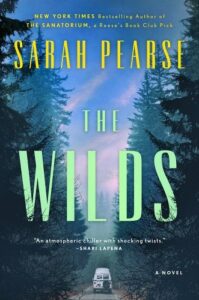Atmosphere is a hugely important part of crafting suspense fiction, conjuring mood and emotion for a reader and contributing to the reading experience in so many ways. The right atmosphere can fully immerse a reader in the world you’ve created, both toying with their emotions and helping them to feel exactly what your characters are experiencing—which in my novels, is usually trepidation or fear!
For me, setting can play a key part in that immersion process. Vivid description and leaning into the sensory detail of a location can really make a reader feel the atmosphere on a visceral level, especially if the setting or landscape you are describing is something that is innately creepy. I like to focus on a few key elements and describe how my characters might feel about seeing them and bringing that experience alive to the reader.
To effectively evoke an intense sense of atmosphere, I need to have spent a lot of time in the setting myself, absorbing the sights and the sounds, even the smells of the landscape. With every one of my novels, that immersion process has been key to creating the right atmosphere within my work.
In my debut novel, The Sanatorium, I utilized not only the naturally atmospheric landscape of the Alps, but also the hotel in which the characters are staying in, a building that has been converted from an old, abandoned sanatorium. I lived in Switzerland, and still spend holidays there, so I really leant on my memories and experiences of being in the mountains, such as the brooding, often sinister feeling of the towering peaks themselves, and what it felt like to be caught in the midst of a ferocious snowstorm.
To get the atmosphere right for the sanatorium building itself, I spent a lot of time studying the exterior of old sanatoriums— not just the cold, clinical, modernist architecture of the exterior, but the interiors too. I watched a lot of urban explorer videos, which gave me a sense of what it would be like to wander the abandoned corridors, see first-hand the discarded clinical ephemera. In writing the book, I drew on these videos and also on my scrapbooks. Scrapbooking is a key part of my writing process; an effortless way for me to refer back to important photographs and texts that have inspired my work. When I’m back at my desk, the scrapbook helps me instantly visualize the world I’m trying to conjure, a short-cut way to inhabit it almost as fully as if I were there.
My second novel, The Retreat, is based in Devon, where I was born and brought up, and while it is a naturally atmospheric place, it’s also a beautiful one, which made the idea of creating a creepy atmosphere quite hard, but it was a challenge that I loved. I really like the idea of subverting what seems to be on the surface a beautiful place and creating a sense of darkness simmering away beneath the surface.
I really lent on the atmosphere the coast has when the weather is wild and stormy, spending time near the island where the book is based, listening to the sound of the waves crashing against the rock, the seagulls screaming overhead and imagining the characters there and how they might feel. Again, this immersion brought some key aspects of the coast alive, particularly the overwhelming sense that the sea itself is so vast and unpredictable. I reflected this sense of chaos in not only the description and mood, but in the characters themselves, to create what I hope is a tense and unpredictable atmosphere.
The Wilds, my new thriller, is set in a Portuguese National Park, and I spent several holidays there, losing myself in the vast wilderness of the park and imagining what it would be like to stay in a camper van, with only a thin wall separating you from might lurk be lurking outside.
I wanted The Wilds to capture not only how wild and remote the park feels, but also the innate claustrophobia of living there from the confines of a camper van. I visited the park several times whilst writing the novel and each time, I came away with something new that helped me conjure the setting more evocatively in the novel, particularly the sensory detail of what it felt like to walk the deserted trails, how the trees and flora and fauna smelt, the slippery sensation of water covered rocks beneath my feet.
To really capture those kind of details in my descriptions, I think carefully about using the right language to create a heightened sensation of awareness in the reader, as if they too, were walking alongside me in the landscape—what would they hear, see, smell?
The words on the page themselves are so important in creating atmosphere and as I start to write, I think about the language in a more granular way, not only about the choice of words I use, but about varying the length of sentences and paragraphs, all of which can have a role in deciding the pace of the story and the sense of tension I’m trying to create. Simile and metaphor can also be powerful here; a way to dial up an image, help a reader make a quick association, particularly when I want to maintain pace in a scene.
Characters themselves are also vital in creating a strong sense of atmosphere, their reactions and thoughts driving all kinds of emotions within readers, taking them along every part of the protagonist’s internal journey—whether the character is experiencing joy, anger, or even sheer terror. In all my novels, Detective Elin Warner describes clearly how she is feeling both directly to the reader and to other characters, something I hope that readers feel only adds to the atmosphere of a chapter or scene.
In summary, I think atmosphere is an integral part of any thriller, but it can’t be created by pulling just one lever, it is something that needs to be considered at every stage of the writing process—from the planning stages when you are brainstorming settings, right through to line level edits when you are making choices on which would be the best word to describe something effectively. I want the reader to feel the atmosphere as something they know is there, but something that never feels awkward or forced, simply suffused into the very DNA of the book itself.
***


















